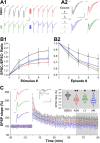This is a preprint.
Synaptic Toxicity of OGA Inhibitors and the Failure of Ceperognastat
- PMID: 40654706
- PMCID: PMC12248022
- DOI: 10.1101/2025.05.09.648606
Synaptic Toxicity of OGA Inhibitors and the Failure of Ceperognastat
Abstract
O-GlcNAcase inhibitors (OGAi) have been proposed as therapeutics for Alzheimer's disease due to their ability to increase O-GlcNAcylation of tau and reduce its aggregation. However, the recent failure of ceperognastat in a Phase II trial-marked by accelerated cognitive decline in the treatment arm-has raised concerns about the safety of this therapeutic class. Here, we evaluated the acute synaptic effects of three structurally distinct OGAi (ceperognastat, ASN90, and MK8719) in mouse hippocampal slices. Electrophysiological recordings revealed that all three compounds impaired both short- and long-term synaptic plasticity, as evidenced by reduced paired-pulse facilitation/depression and suppressed long-term potentiation. Immunohistochemistry showed altered synaptic protein levels, with increased PSD-95 and reduced Synaptophysin 1 in neurons, alongside a biphasic shift in Tau phosphorylation. These findings indicate that OGAi produce rapid and convergent synaptotoxic effects across pre- and postsynaptic compartments, likely reflecting a class-wide mechanism. We argue that electrophysiological screening should be standard in CNS drug development and caution against targeting essential synaptic processes in chronic neurodegenerative conditions.
Conflict of interest statement
Drs. Liu, Zhang report grants from National Institute on Aging during the conduct of the study. No other disclosures were reported.
Figures


Similar articles
-
The Black Book of Psychotropic Dosing and Monitoring.Psychopharmacol Bull. 2024 Jul 8;54(3):8-59. Psychopharmacol Bull. 2024. PMID: 38993656 Free PMC article. Review.
-
Management of urinary stones by experts in stone disease (ESD 2025).Arch Ital Urol Androl. 2025 Jun 30;97(2):14085. doi: 10.4081/aiua.2025.14085. Epub 2025 Jun 30. Arch Ital Urol Androl. 2025. PMID: 40583613 Review.
-
Short-Term Memory Impairment.2024 Jun 8. In: StatPearls [Internet]. Treasure Island (FL): StatPearls Publishing; 2025 Jan–. 2024 Jun 8. In: StatPearls [Internet]. Treasure Island (FL): StatPearls Publishing; 2025 Jan–. PMID: 31424720 Free Books & Documents.
-
Systemic pharmacological treatments for chronic plaque psoriasis: a network meta-analysis.Cochrane Database Syst Rev. 2017 Dec 22;12(12):CD011535. doi: 10.1002/14651858.CD011535.pub2. Cochrane Database Syst Rev. 2017. Update in: Cochrane Database Syst Rev. 2020 Jan 9;1:CD011535. doi: 10.1002/14651858.CD011535.pub3. PMID: 29271481 Free PMC article. Updated.
-
Systemic pharmacological treatments for chronic plaque psoriasis: a network meta-analysis.Cochrane Database Syst Rev. 2021 Apr 19;4(4):CD011535. doi: 10.1002/14651858.CD011535.pub4. Cochrane Database Syst Rev. 2021. Update in: Cochrane Database Syst Rev. 2022 May 23;5:CD011535. doi: 10.1002/14651858.CD011535.pub5. PMID: 33871055 Free PMC article. Updated.
References
-
- Kielbasa W, Goldsmith P, Donnelly KB, et al. Discovery and clinical translation of ceperognastat, an O-GlcNAcase (OGA) inhibitor, for the treatment of Alzheimer’s disease. Alzheimer’s & Dementia: Translational Research & Clinical Interventions. 2024;10(4):e70020. doi: 10.1002/trc2.70020 - DOI - PMC - PubMed
Publication types
Grants and funding
LinkOut - more resources
Full Text Sources
